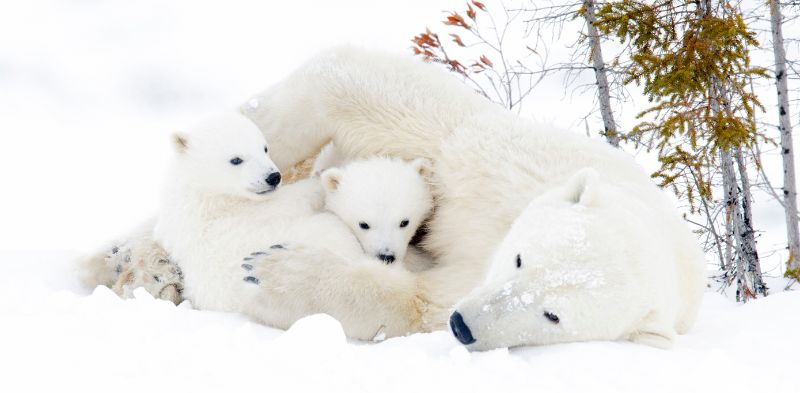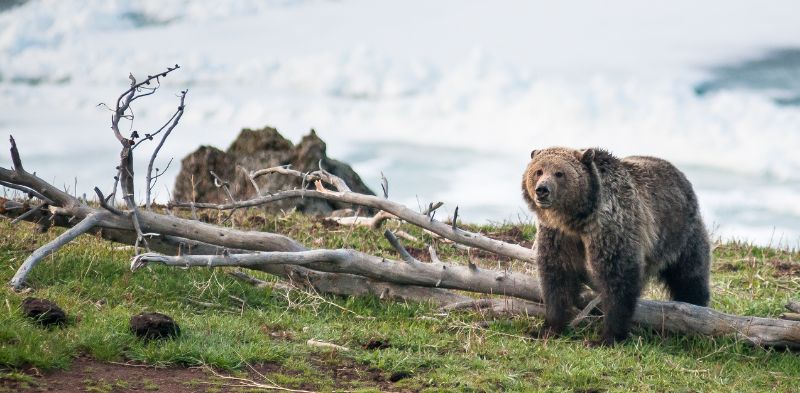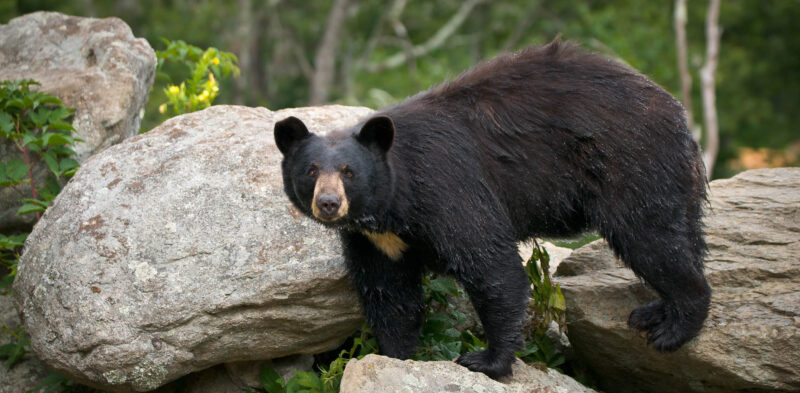There are three types of bears living in the US: polar bears, grizzly bears, and black bears. Each species is known for unique physical characteristics, behaviors, and adaptations.
With an estimated 900,000 black bears and a vulnerable status for polar bears, it’s crucial to recognize their significance in the ecosystem and the efforts needed to preserve them.
If you want to learn more about the characteristics and differences between species that lives on the North American continent, we will share some interesting details in the following sections.
| Characteristic | Polar Bear (Ursus maritimus) | Grizzly Bear (Ursus arctos) | American Black Bear (Ursus americanus) |
|---|---|---|---|
| Size (Height) | Up to 10 feet | Up to 8 feet | Up to 5.5 feet |
| Weight | Up to 1,000 pounds | Up to 1,000 pounds | Up to 660 pounds |
| Color | White, can appear yellowish | Light to dark brown, sometimes black | Black, brown, cinnamon, gray, white |
| Habitat | Arctic regions, sea ice | Forests, mountainous regions, coastal areas | Forests, mountains, swamps |
| Diet | Primarily carnivorous (seals) | Omnivorous (varies with region and season) | Omnivorous (fruits, nuts, insects, small mammals) |
| Lifespan | 15-25 years | 20-25 years | 10-20 years |
| Conservation Status | Vulnerable | Threatened in some areas | Least Concern (Some subspecies threatened) |
| Behavior with Humans | Avoids humans, but can be dangerous | Can be aggressive, more likely to attack | Generally avoids humans, less aggressive |
Types of Bears and Their Characteristics
As we already mentioned, North America is home to three primary bear species: the polar bear, the brown (or grizzly) bear, and the American black bear. Each species exhibits distinctive physical attributes and behaviors that set them apart from one another.
The polar bear, known for its striking white fur, is the largest and most carnivorous, primarily residing in the Arctic. The brown bear, including the famous grizzly, is recognized for its significant size and the pronounced shoulder hump. The American black bear, the most common and widely distributed, is smaller and varies in color from black to cinnamon.
Differences Between the Bear Species
Understanding the differences between these bears is crucial for their identification and conservation. Polar bears, the largest species, can weigh up to 1,000 pounds and stand up to 10 feet tall.
Their long, powerful snouts and large, black noses are adapted for a life in the harsh Arctic environment. In contrast, brown bears, including the grizzlies, can reach similar weights but stand a bit shorter at up to 8 feet.
They are distinguished by their large muscle mass over the shoulders and a concave, dish-shaped face. American black bears are the smallest of the three, with maximum weights of around 660 pounds and a height of up to 5.5 feet.
Unlike the pronounced shoulder hump of the brown bear, black bears have a smaller or almost non-existent hump. Their facial profile is straighter, and they exhibit a wider color range, including black, brown, cinnamon, and even shades of gray.
Natural Habitats and Inter-Species Contact
Polar bears primarily inhabit the remote Arctic regions, traversing sea ice for hunting. Brown bears are more widespread, found in regions like British Columbia, Alberta, and parts of the northern United States.
The American black bear has the broadest range, inhabiting forests across Canada and the United States. While there is some overlap in the habitats of brown and black bears, particularly in the Pacific Northwest, polar bears are typically isolated in the Arctic, reducing the likelihood of inter-species contact.
Behavior and Human Interaction
When it comes to danger and human interaction, each species exhibits different behaviors. Grizzly bears are often considered the most aggressive towards humans, leading to more recorded attacks.
However, polar bears, given their size and carnivorous diet, are potentially the most dangerous. Despite this, polar bear attacks are rare due to their remote habitat. American black bears are generally less aggressive and more likely to retreat in human encounters.
In a hypothetical fight, the polar bear’s size and strength give it an advantage, but such interactions are practically non-existent in the wild. As for fatalities, grizzly bears have a higher incidence of fatal attacks in North America.
However, it’s important to note that bear attacks are rare, and most bears prefer to avoid humans. Conservation efforts focus on minimizing human-bear conflicts and educating the public about bear safety to protect both humans and these majestic animals.
Polar Bears

Polar bears, known scientifically as Ursus maritimus, are not just the largest bear species in North America but also the most specialized in terms of habitat and diet. These majestic creatures are uniquely adapted to the cold Arctic environment, a fact that influences almost every aspect of their biology and behavior.
Diet and Hunting Techniques
Polar bears are exceptional hunters, primarily preying on ringed and bearded seals. They use a method called still-hunting: patiently waiting by a seal’s breathing hole in the ice and then striking swiftly when a seal emerges. This hunting strategy demonstrates their intelligence and patience, crucial traits for survival in the harsh Arctic.
Lifespan and Reproduction
In the wild, polar bears can live up to 25 years, although the average lifespan is about 15 to 18 years. They reach sexual maturity at about four to six years of age.
The reproductive process is fascinating, with the female entering a state known as delayed implantation, where the fertilized egg doesn’t immediately implant in the uterus. This adaptation ensures the cubs are born at a time when the mother has sufficient fat reserves to nurse them in the den through the Arctic winter.
Conservation Status and Threats
Polar bears are currently classified as a vulnerable species. The primary threat to their survival is climate change, which is causing a rapid decline in Arctic sea ice. This loss of habitat directly impacts their ability to hunt seals and find mates. Additionally, pollution and industrial activities in the Arctic are posing significant risks to their health and environment.
Unique Adaptations and Behavior
Polar bears are the only bear species classified as marine mammals. They are excellent swimmers, capable of covering long distances in search of food or habitat. Their paws are specially adapted for swimming, with partially webbed toes to aid in propulsion. On land, they can run at speeds of up to 25 miles per hour over short distances.
Grizzly Bears

Grizzly bears, often referred to as brown bears in North America, are a symbol of wilderness and strength. Scientifically known as Ursus arctos, grizzlies are distinguished by their impressive size, muscular hump on their shoulders, and fearsome claws. These bears are predominantly found in the western part of North America, particularly in Alaska and parts of Canada.
Diet and Foraging Habits
Grizzly bears are omnivores with a diet that can vary greatly depending on their habitat and the season. In coastal areas, salmon is a significant food source, while in inland regions, they may consume more nuts, berries, plant roots, and small mammals.
Grizzlies are known for their incredible foraging abilities, often traveling great distances to find food, and they play a crucial role in their ecosystems as seed dispersers and as predators.
Lifespan and Reproduction
Grizzly bears have a lifespan of around 20 to 25 years in the wild. They reach sexual maturity at around 3 to 8 years old, with females generally maturing earlier than males.
Mating occurs from May to July, and like polar bears, grizzlies have a delayed implantation, with the fertilized egg implanting in the uterus later in the year and cubs born in the winter den.
Conservation Status and Human Impact
Historically, grizzly bears roamed throughout much of western North America, but their range has significantly diminished due to habitat loss and hunting.
Today, they are listed as a threatened species in the contiguous United States and are protected under various conservation laws. Human-bear conflicts are a significant challenge in areas where grizzlies and human populations overlap.
Unique Characteristics and Behavior
Grizzlies are known for their formidable strength and agility, despite their large size. They can run up to 35 miles per hour and are excellent swimmers. The hump on their shoulders is a mass of muscles that gives them the strength for digging and foraging. Grizzly bears are generally solitary animals, except for mothers with cubs or during seasonal food abundances like salmon runs.
Black Bears

Renowned for their adaptability to various habitats, these bears are smaller and generally more timid than their grizzly or polar bear counterparts. Black bears can be found in a range of environments, from dense forests to mountainous regions and even in swampy areas.
Diet and Foraging Behavior
American black bears have an omnivorous diet that is highly adaptable based on available food sources. They primarily consume fruits, nuts, and vegetation, but also eat insects, fish, and small mammals.
This adaptability plays a crucial role in their survival across diverse habitats. Black bears are also known for their ability to remember food sources and return to them yearly.
Lifespan and Reproduction
Black bears can live up to 20 years in the wild, though 10 to 15 years is more common. Females reach sexual maturity around 3 to 5 years of age and mate every other year.
Cubs are born during the mother’s winter hibernation and stay with her for about 18 months. Unlike grizzly bears, black bears do not have a pronounced shoulder hump or dish-shaped face.
Conservation and Population
With an estimated population of over 900,000, American black bears are not currently considered an endangered species. However, some subspecies, like the Louisiana black bear, have been on the threatened list. Habitat loss and human-bear conflicts are the primary concerns for black bear conservation.
Unique Traits and Adaptations
American black bears are known for their climbing skills, often scaling trees to escape danger or find food. They have shorter, non-retractable claws that make climbing easier.
Black bears are generally less aggressive than grizzlies and tend to avoid human encounters. They can range in color from black to cinnamon, brown, and even gray or white in rare instances.
FAQs
How intelligent are bears?
Bears are very intelligent animals that can learn, communicate, and adapt to their environments. They have excellent memory, spatial awareness, social skills, and emotional intelligence. Some bears can even count, use tools, and recognize supermodels.
Do bears have weaknesses?
Bears are powerful and resilient, but they also have some weaknesses. Bears have poor eyesight and can overheat during chases. They depend on unpredictable food sources and cannot digest mature vegetation. They also face threats from habitat loss, human-wildlife conflict, and illegal wildlife trade.
What is the most unique bear?
All bears are unique in their own ways, but one of the most distinctive bears is the polar bear. The polar bear is the largest and most powerful carnivore on land, and the only bear that is hyper-carnivorous. It has translucent fur, black skin, and adaptations for living in the Arctic. It is also vulnerable to climate change and sea ice loss.
What does a bear symbolize?
A bear symbolizes strength, courage, confidence, and leadership. It also represents protection, wisdom, healing, and balance. As a spirit animal, a bear can help you overcome your fears, stand your ground, and appreciate the simple pleasures of life.
Summary
The Polar Bear, Grizzly Bear, and American Black Bear each hold a unique place in North America’s wildlife tapestry. Despite their differences in size, habitat, and diet, these bear species share common threads that weave into the larger story of the continent’s diverse ecosystems.
Also, there are some other interesting features that you may find interesting, for example, you should check out what is the difference between a male of a female bear, or can they swim.
Related Posts:
- Connecting Kids to Nature: Making Ecology Homework…
- How Do Wild Horses Survive? - A Fascinating Study
- What Sounds Does A Chipmunk Make: Study In Animal…
- Why Do Otters Hold Hands? Learn More About This…
- Water Conservation 101: Practical Eco-Friendly…
- What Are Pizzly Bears And Grolar Bears? - Hefty Hybrids!








